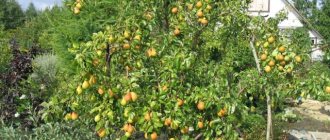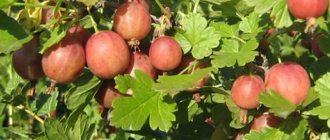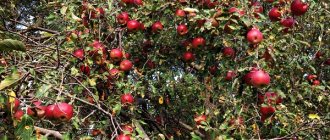History of selection
The culture was bred in 1995 at the South Ural Research Institute of Fruit and Potato Growing. The plant received its second name Vladil in honor of its creator, Professor Vladimir Ilyin.
The following parent forms were used in the selection of this variety:
- African;
- Chelyabinsk.
The commander harmoniously combined the qualities of both varieties.
Did you know? Gooseberries contain pectins, substances that allow the removal of heavy metal salts from the body.
Characteristics, description
Characteristic botanical features of the culture in question:
- medium-sized bushes, up to 1.5 m high, slightly spreading, densely leafy;
- young growths are not pubescent, slightly curved at the base;
- the bark in places most exposed to the sun changes its color from greenish-brown to pinkish;
- the shoots are not thorny, rare thorns may appear at the base of the bush, but they are very soft and do not interfere with care;
- leaves are five-lobed, large and medium-sized, green, glossy;
- the leaf plates are arranged alternately, attached to the shoots using petioles of medium length, painted light green or yellowish;
- flowers are small yellow-green, cup-shaped, grouped in 2–3 pieces;
- the berries weigh 5.6–7 g and are colored burgundy-brown.
The berry tastes sweet with a slight sourness.
The ripening of berries lasts approximately from the end of May to the end of June. By mid-July, part of the harvest is ready for harvest. Even if the collection cannot be completed on time, there is no reason to worry. The berries stay on the branches for a long time and do not fall off even after reaching full ripeness. They have a thin skin, which practically does not affect the taste. The pulp is very juicy and contains a small amount of black seeds.
The culture is resistant to fungal diseases such as powdery mildew, late blight, anthracnose, as well as diseases of viral origin. Among pests, it is resistant to moth and sawfly.
Did you know? The Old Russian name for gooseberries is bersen.
The variety is not resistant to:
- rust;
- drying of stems;
- white spotting;
- gray rot;
- mosaic disease;
- gall midge;
- aphids;
- moth;
- ticks;
- glass
If the vegetation is cared for correctly and in a timely manner, preventive treatments are carried out, the above diseases and parasites rarely affect the variety.
Reviews
★★★★★
Marina, 48 years old, summer resident, Rostov-on-Don. Commander is a good gooseberry, I use it for making preserves and jams.
Unlike other varieties, I never got sick. ★★★★★
Ivan, 60 years old, gardener, Moscow. I love the Commander for his unpretentiousness.
I have 3 bushes growing and have never had any problems with pests or diseases. The only thing is that the berry becomes very small if the bush is not trimmed. ★★★★★
Boris, 41 years old, gardener, Voronezh. The commander left it for variety.
The taste is mediocre, I don’t like the sour skin. We practically don’t use it for fresh consumption; we process it into jam. Hide
Add your review
Gooseberry Commander has no thorns and is famous for its productivity and frost resistance. The skin is thin, sour, the flesh is juicy, sweet and sour. With regular pruning, the berries do not become smaller. Due to poor keeping quality, ripe fruits are recommended to be consumed immediately.
0
0
Copy link
Advantages and disadvantages
In order to better organize the care of vegetation, it is necessary to carefully study its pros and cons.
- The main advantages of the variety:
- good stable yield;
- the ability to transport fruits over long distances;
- versatility of crop use;
- thornless shoots;
- good immunity to viral diseases, some fungal diseases and pests;
- high frost resistance;
- the ability of vegetation to tolerate short-term drought.
Like any crop, this one has its drawbacks. But compared to the advantages, there are very few of them. Plus, some are easy to fix with proper care.
- Disadvantages of Komandor variety gooseberries:
- resistance to not all fungal diseases and pests;
- Fresh berries do not last long.
Drought resistance, frost resistance
The culture tolerates temperature drops in winter down to -35°C even without additional shelter. However, now that the climate has begun to change and little snow falls during the cold season or it quickly melts as a result of frequent thaws, it is still better to play it safe and cover the plantings with agrospan.
The crop also shows good resistance to drought. Plants can withstand short periods of intense heat without watering. If the plantings are not watered for too long (about 1.5 weeks), this will negatively affect the overall development and fruiting.
Rules for caring for the variety
As soon as the first leaves appear on the crop, it must be fed with a solution of urea and nitrophoska.
The next time you need to add nutrients is as soon as the plant begins to bloom. Potassium sulfate and “Berry” fertilizer should be diluted in a bucket of water (proportion 1:2). Before fertilizing the soil, it should be evenly sprinkled with tree ash around the bush.
The third application of substances beneficial to the plant is carried out during the period of fruit set. It is enough to dilute nitrophoska and potassium humate (proportion 1:2) in a bucket of water and pour this solution over the gooseberries.
During the summer, caring for berries comes down to mandatory deep loosening of the soil and systematic watering. You need to moisten the Olavi bush at the root. The sprinkling method promotes the spread of diseases, so it should not be used. Water for irrigation should be warm.
At the end of autumn, the soil under the fruit-bearing bushes should be sprinkled with a layer of peat or sawdust, hilled up and left in this form for the winter. With the onset of spring, the mulch layer is removed, and the soil is loosened to a depth of 0.15 meters, which accelerates the heating of the roots.
Gooseberries of the Olavi variety are not very well known among gardeners today. However, the ease of caring for the crop, high yields and other advantages undoubtedly speak in its favor.
Landing
One of the most important stages that determine the future level of productivity is planting and preparation for it. To begin with, it is worth deciding on the timing of the manipulation, based on the climate characteristics of your region. After this, it is worth paying attention to the area that will be allocated for planting gooseberries. It must be selected in accordance with the botanical characteristics of the plants, and then preparatory measures must be carried out with the soil.
Find out also how to properly tie gooseberries.
Deadlines
Planting of the gooseberry variety in question can be done in spring and autumn. The first option is suitable for all regions without exception, the second - only for the southern regions, which have mild winters. Spring planting should be done before sap flow begins in the shoots and the buds begin to swell. Autumn planting should be carried out 3 weeks before the onset of frost.
Choosing a suitable location
The area for planting gooseberries must be selected taking into account lighting and humidity. It is best to place plantings in the southern or southeastern part of the territory. The optimal level of groundwater is 1.5–2 m. The composition of the soil is not particularly important. However, the best yield results are observed on loose, light soils. The main requirement is acidity. It should vary between 5–7 pH.
Important! Even in partial shade, the Komandor variety will develop poorly, which will significantly reduce the yield.
Regardless of what time of year the planting is planned, preparatory work on the site should begin six months before it. First you need to clear the area of debris and plant debris. After this, the soil needs to be dug up to a depth of 40 cm. This approach helps to increase the level of oxygen in the soil and destroy the homes of parasites/harmful bacteria that usually overwinter in its upper layers.
Immediately after plowing, additional disinfection is carried out using a 3% concentration of copper sulfate solution. To obtain it, add 300 g of powder to 10 liters of water. For every 10 m² of area, 1 liter of working fluid is consumed. A week after disinfection, the soil is again dug to a depth of 20 cm, after adding 10 kg of humus, peat, manure and 100 g of superphosphate to each m².
How and when to plant
It is best to plant seedlings in the fall - this way there is a greater chance that the plant will take root. If there is an option to buy shoots in the spring, they must be planted before the awakening begins. The soil for planting is prepared in advance, about a week in advance. The distance between seedlings and other shrubs should be at least a meter. If a tree grows nearby or there is a tall building, it is better to increase the gap to two to three meters so that the shadow does not block the sunlight. In this case, you can’t count on high yields, because gooseberries are a light-loving plant. And here’s what the gooseberry variety Kolobok looks like, and how to plant it correctly. outlined in the article at the link.
Landing algorithm:
- It is necessary to dig a hole at least 30 centimeters deep and half a meter in diameter. Humus mixed with superphosphate (about 50 grams) and potassium salt is added to the bottom of the hole. The last ingredient can be replaced with a half-liter jar of wood ash.
- It is advisable to let the hole stand for a while, but you can dig it just before planting.
- It is also better to soak the purchased seedling in warm water . To accelerate root growth, you can add a little potassium humate or another growth stimulant (Zircon, Epin and others). Most of these preparations also add a disinfectant that protects the roots from fungus and other characteristic diseases.
- The seedling is placed vertically upward and covered with earth . The root collar deepens; you need to make a hole on top for watering.
- After planting, the plant is watered abundantly; it is advisable to mulch the root area.
- The seedling is pruned at the level of the fifth bud so that the plant can take root better.
You may also be interested in the Prune gooseberry variety, and what conditions need to be created for its cultivation.
On the video - how and when to plant gooseberries:
Twigs cut from gooseberries can be buried immediately. With proper care, there is a possibility of their rooting. In this way, you can propagate gooseberries yourself, and sprouts cut from an adult plant have a high chance of taking root.
Features of seasonal care
Caring for gooseberries of this variety is quite simple. You just need to carry out a number of standard agrotechnical measures in a timely manner. They are aimed at maintaining soil fertility and preventing diseases. Don’t forget about annual pruning, which will help achieve better yield results.
Soil care
Watering is carried out 1–3 times a month depending on climatic conditions. Apply 20 liters of water to each bush. After each moistening, artificial or natural, loosening is carried out to a depth of 5 cm with the accompanying removal of weeds.
Important! You should not use peat as mulch - it acidifies the soil, which will not benefit the gooseberries at all.
To avoid rapid evaporation of moisture from the soil, as well as the spread of diseases, pests and weed germination, mulching is carried out after loosening . You can use hay, compost or freshly cut grass for this.
Preventative treatment
The main preventive measure to prevent the proliferation of bacteria and parasites is proper care . It is very important to carry out watering, fertilizing, loosening and mulching in a timely manner. With a lack of nutrition and moisture, the immunity of vegetation weakens. A favorable environment appears for the proliferation of harmful microorganisms.
Much more often, plantings that are too thick and whose branches lie on the ground are susceptible to various diseases and pest attacks. After the end of the season, it is important to remove all foliage and plant debris from the site. It is in this material that bacteria and parasites like to settle. They overwinter well in last year's foliage, and in the spring they begin their vigorous activity.
In addition, to maintain the immunity inherent in vegetation at the genetic level, in the fall, copper sulfate should be sprayed over the ground and soil in a 1% concentration. To prepare a solution, add 100 g of powder to 10 liters of water. In the spring it is also necessary to carry out treatment. But it is better not to use copper sulfate, so as not to provoke the accumulation of copper in the soil and plant tissues. For spring treatment, the drug “Emochka-Fertility” is suitable. For 10 liters of water add 1 tbsp. l. substances. Treatment is carried out on the ground part and soil.
We recommend that you learn how to treat gooseberries with soda against powdery mildew.
Feeding
The plants will not need additional nutrition in the first year of life on the site. What was added at the time of planting will be enough for them. From the second year, they begin to fertilize 2 times a season: in spring and autumn.
At the end of April, a manure infusion is diluted for each bush. To 10 liters of water add 1 liter of liquid mullein or 300 g of dry chicken manure. In the fall, 3 weeks before frost, 100 g of superphosphate and 20 g of potassium salt are embedded into the soil for each m² of tree trunk circle.
We suggest you familiarize yourself with how to properly tie gooseberries.
Support
The gooseberry variety in question needs to be supported so that the branches do not break under the weight of the fruit. To do this, you can use sticks forked at the top. They are placed under sagging shoots. Or you can use special supports for bushes, which are sold in any hardware stores.
They can look different (circular, square, pyramidal, etc.).
They are installed immediately after planting . Such supports are easily placed on seedlings, and as the bush develops, they prevent its branches from falling to the ground. In addition, they make the gardener’s task easier when pruning and harvesting.
We recommend reading how and when to properly prune gooseberries in the fall.
Trimming
During the first 3–4 years after planting, bushes are formed. The beginning of this process is the shortening of the shoots at the time of planting. The manipulation is carried out in the spring, before the buds begin to swell. On branches shortened before planting, by the next season 4 to 6 new growths up to 40 cm long will have already formed.
Of these, 3–4 developed shoots are selected, shortened by a third, and the rest are cut to zero. In the 2nd and 3rd years after planting, 3–5 branches are left from the root shoots, the rest are cut out. On one-year-old shoots, 2 strong growths are left, everything else is cut out. By the 4th year, pruning will be reduced to removing branches that thicken the crown and compete with skeletal ones.
Six-year-old bushes begin to gradually rejuvenate. To do this, 3 shoots are completely cut out every year, which bear fruit poorly and produce a growth of less than 30 cm per year. In return, they are given the same number of one-year-old root shoots each time.
To carry out the manipulation, use a well-sharpened pruner. First, it is dipped in alcohol or a solution of copper sulfate of 1% concentration. Immediately after cutting, all wound surfaces are treated with wood ash and covered with garden pitch.
We advise you to find out in more detail at what temperature from each other it is recommended to plant gooseberry bushes.
Learning to care
To get the maximum yield from a variety, you need to follow simple rules. Don't be lazy to loosen the soil regularly. Just do it carefully, because... the roots are located close to the surface. The first loosening is carried out after the snow has melted. During the summer, the procedure is carried out at least 5 more times. In the fall, the beds are cleared of debris, which will deprive the “cozy home” of pest larvae, fungal spores, and bacteria.
“Commander” loves moisture, but it cannot be flooded - stagnation of liquid will cause rotting of the roots. In hot summers, water every day (2 liters per bush). At the end of summer, the amount of watering decreases - water every 1-2 days. On cloudy days, once a week is enough. Don't forget to mulch the ground with peat or hay.
Water with a spray bottle or by filling the grooves. If you water at the root, the soil will be washed away and the gooseberries will begin to dry out.
The dense foliage of "Commander" requires pruning. Pruning is done in spring and autumn. Remove broken, damaged, diseased branches growing deep into the crown. Without regret, cut off branches older than 6 years - they will no longer bear fruit. Spring pruning is carried out before the leaves appear, autumn - after they fall. Don't delete many branches at once. For the bush this is stress.
If you plant gooseberries in the fall, then during spring digging, fertilize the soil with urea at the rate of 15 grams. per 1 m2. Every spring add compost (6 l), ammonium sulfate (30 g), superphosphate (60 g), potassium nitrate (25 g). 20 days after flowering ends, organic matter is added. At the beginning of summer - complex fertilizers. When diluting, strictly follow the instructions. One adult plant will require 20-25 liters. During fruit setting, gooseberries are watered with Potassium Humate (50 g).
"Commander" is resistant to low temperatures, but it is better to play it safe and protect it. In late autumn, the soil is carefully dug up, the plants are covered with burlap, spunbond, agril or any other material that allows air to pass through. If weather forecasters promise a harsh winter, then you should tie the branches and bend them to the ground - then they will definitely not break under the influence of the snow cover.
Harvesting and storage
Fruits are harvested as they ripen. Considering that the berries need to be separated from the branches along with the stalks, it is better to collect them using small, well-sharpened scissors. The harvest is sorted by rejecting specimens.
To extend their shelf life, the berries are frozen or sent for processing.
Whole, beautiful fruits are placed in boxes with low sides, having previously lined the bottom with parchment. At a temperature of +18°C and a relative humidity of 80%, the fruits remain fresh for 4-5 days, and at a temperature of +5...+8°C - for a week.
Read more about how to deal with sawfly on gooseberries.
Preparing for winter
Typically, in regions where the temperature in winter does not fall below -35°C, plants do not require shelter. The main thing is to carry out a number of measures to protect the roots from freezing. To do this, 3 weeks before frost, preventive treatment with copper sulfate is carried out (1% concentrate is sprayed on the ground part and soil), after 4 days - the last watering. Apply 20–30 liters of water under the bushes.
A day later, fertilize with superphosphate and potassium salts, then mulch the tree trunk circle. The thickness of the mulch layer should be 10–15 cm. If winters have little snow, then bend the branches to the soil and pin them with metal staples. Then they are covered with agrofibre.
Find out more about how to properly scald gooseberry bushes with boiling water.
Gooseberry Commander - pruning
Gooseberry Komandor is pruned in spring and autumn.
. At the same time, all diseased, weak and damaged stems are removed, as well as those shoots that are more than 7 years old, since they no longer produce berries.
Proper pruning of gooseberries in spring - video
A properly formed gooseberry bush has no more than 18 stems of different ages
. During one pruning, you cannot remove more than a third of all branches, otherwise the bush will hurt for a long time.
How to prune gooseberries correctly
Reproduction methods
Vegetation is propagated by layering easier and of better quality. To obtain planting material, around September - October, zero annual growths are selected on bushes 6 years old. Each shoot is bent to the soil and pinned with staples. Then sprinkle with a layer of soil 10 cm high, water generously and mulch with a layer of sawdust 5 cm thick.
In the spring, the buried layerings begin to be cared for as standard for an adult plant. By autumn the shoots will sprout and take root. At this moment, they are separated from the mother plant, dug up and divided into equal parts according to the number of sprouts that have sprouted. Each of them is planted in a separate peat container for growing. The soil for seedlings is mixed from sand, peat, compost and garden soil. All elements are connected in a ratio of 1:1:1:1. In spring, seedlings can be planted in a previously prepared place.
Dividing the bush gives good results. To carry out propagation in this way, plants of three years old are selected. The manipulation can be carried out in spring or autumn. The bushes are dug up and divided into 2 parts so that an equal number of roots remain on them. The resulting planting material is placed on a previously prepared area.
Diseases and pests
Possible problems when growing Komandor gooseberries and ways to solve them:
| Name of disease/pest | Struggle |
| Rust | Remove affected parts of the plant. Carry out the treatment with Fitosporin according to the instructions. |
| Drying of stems | Trim dried stems, taking 10 cm of healthy tissue. Treat all wound surfaces and cracks on shoots with Bordeaux mixture of 1% concentration. |
| White spot | Eliminate infected shoots and foliage. Spray the leaves and soil with Nitrophen according to the instructions. Repeat the manipulation for prevention after harvesting and in the spring before flowering. |
| Mosaic disease | The disease cannot be cured. When its symptoms appear, infected specimens should be uprooted and burned, and green manure plants should be planted in their place. |
| Gray rot | Carry out sanitary pruning. Treat the bushes with Fitosporin according to the instructions. |
| Gall midge, moth | Treat the bushes with wormwood infusion (add 1 kg of herb to 5 liters of boiling water, leave for 30 minutes, dilute 1:1 with water). Spray on the leaves and soil for a month at intervals of 3 days. |
| Glassware | Sprinkle mustard powder under the bushes, after loosening the soil to a depth of 10 cm. Treat the leaves with wood ash. |
| Mites, aphids | Remove damaged plant tissue. Spray the leaves and soil with wood ash or tobacco dust. |
The described difficulties arise only when improper care is carried out or a sudden change in climatic conditions (frequent thaws in winter, high humidity, etc.) . Otherwise, plants of this variety are very rarely affected by harmful microorganisms.
Did you know? Gooseberries and currants are closely related crops. As a result of their crossing, the yoshta plant was obtained, which combines the features of both plants.
The gooseberry variety Komandor has proven itself well among Russian farmers as a highly productive crop. It tolerates frosty winters well, even without shelter, and is rarely affected by diseases and pests.
Gooseberry Commander: agricultural technology for growing, planting and care
Seedlings of the Komandor variety are planted in both spring and autumn.
. The main thing is to choose the right area for planting. It should not be located in a lowland or in a place where groundwater comes close to the surface of the earth.
Useful article:
Planting gooseberries in spring
The best soils for Komandor gooseberries are sandy loam, loamy or soddy-podzolic, loose and fertile
. The area should be well lit by sunlight and protected from gusts of cold winds.
The landing pit should have dimensions: 0.6 * 0.6 m.
The soil selected from the pit is mixed with 10 kg of rotted manure, 5 cups of wood ash and approximately 350 g of dolomite flour are added. A healthy gooseberry seedling should have at least 6 strong roots about 9-10 cm long.
Interesting!
Potassium nitrate - use in the garden
The seedling is placed in the hole strictly vertically, the roots are straightened along the diameter of the hole. The root collar is buried by about 5 cm. The hole is filled with prepared nutrient substrate, compacted and watered - at least 5 liters of water are needed for each gooseberry seedling. You can add a layer of mulching material on top.
Planting gooseberries in spring - video
Although the Komandor gooseberry variety is relatively unpretentious, some agrotechnical measures must be carried out
. The soil in the tree trunk circle is loosened several times a season, but not deeply, so as not to damage the roots, which are located close to the surface.
In hot weather, plants are watered every day, adding up to 3 liters of settled water under each root.
. If the weather is rainy, then it is enough to water this gooseberry once every 6-8 days.











